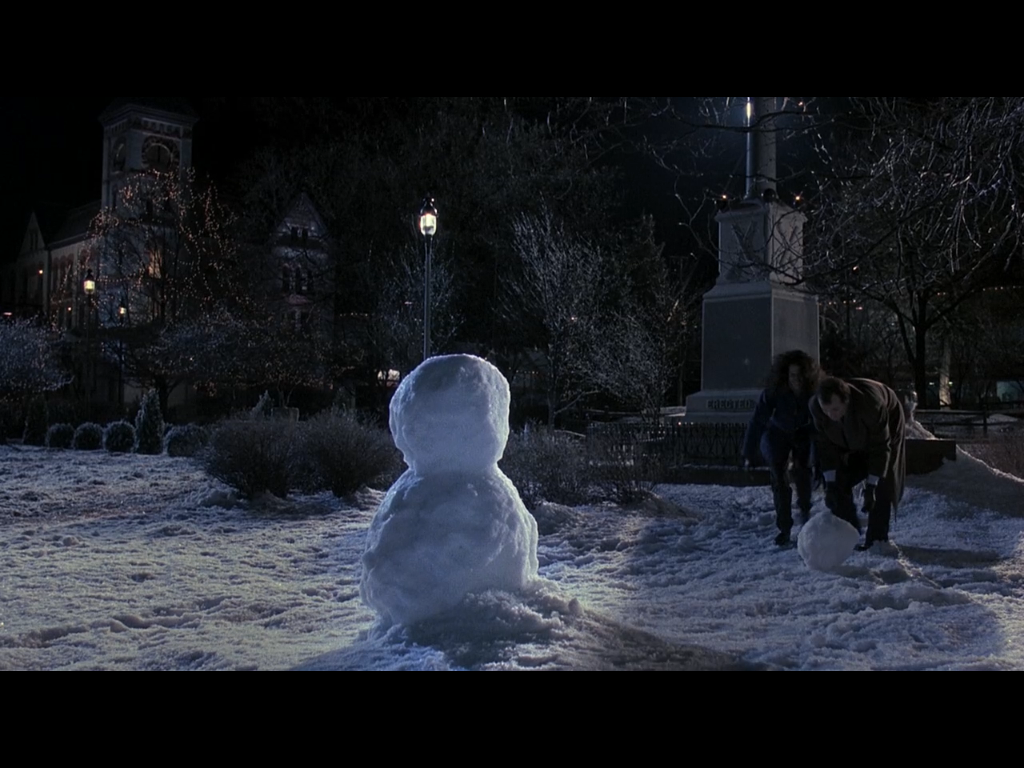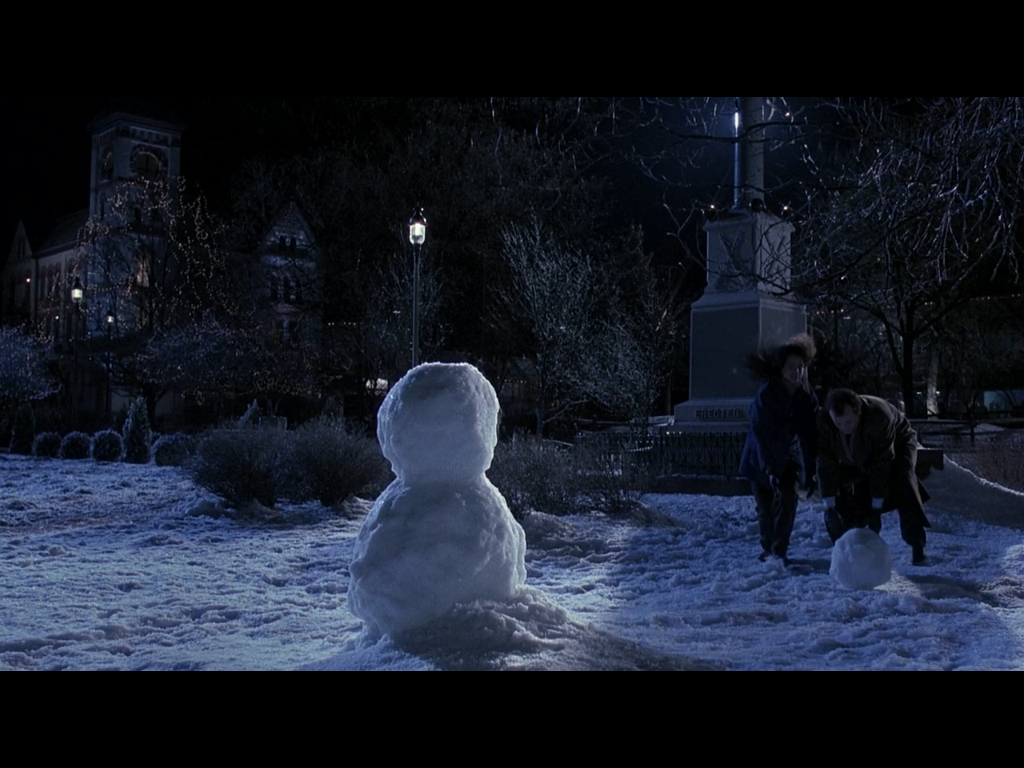good, clean fun
I found it amusing, reading Benesh (2011), that she only watched the (entire) film 8 times over the course of 2 months (p. 65). In describing how she collected images and symbols within the film, she also suggests that "even after multiple viewings, it is impossible to list every image and object and less so to analyze such" (ibid). If nothing else, the purpose of The Groundhog Day Project is to prove that statement false.
For example, Benesh does list the snowman, though she deals with it in terms of the color white and spheres--I've already suggested that "snowmen and snowballs" are "perfectly reasonable objects to have in a story set in midwinter." Same for the color white. The color blue, in which Benesh also sees significance--obviously I think there's something going on there. But, with white? I don't think so. As for the snowman (or snowmen, really, since we see two of them... sort of), I think there's a better line of symbolism to argue than the color white or the spherical shape. The snowman's body is the same on both nights we see it. Here's the evidence:


There are in the film already two Phils, literally, with Phil Connors and Punxsutawney Phil, and two Phils, figuratively, with the pre-/early-loop Phil and the late-/post-loop Phil. Here we get a snowman with two heads. In context of the film, of course, these two snowmen are supposed to be entirely separate entities created on separate days. For practical purposes, during production, I assume these two scenes were filmed right in a row on the same night. Hell, that might even be the same head, as the second head does seem a little smaller than the first one; i.e. it got smaller from them taking it back down and handling it again.
Benesh lists off numerous pairs of things on display in the film and she calls the two snowman scenes a pair (p. 73). However, she doesn't suggest the snowmen are a pair, nor does she notice (apparently) that they are, in fact, the same snowmen just with the head changed (or replaced). The symbolism Benesh misses here, then, is that like Phil Connors, always the same body day in and day out but with his head (internally, of course) changing over time, the snowman is timeless on the "outside" (his body) but is different on the "inside" (his head) for his second appearance. The head is also the outside, literally, but synecdochally represents what's inside the head, but let's not belabor that point.
I think with more viewings, Benesh might have caught that one.
Another symbol, or allusion, that Benesh misses comes when she writes of the colors blue and white. At one point she says:
Blue and white are associated with light and shadow, respectively; and light and shadow with ego consciousness and its opposite: all that is repressed, disowned, rejected, and disidentified. White is associated with enlightenment, light blue with meditation, and dark blue with dreams (Chevalier & Gheerbrant, 1996, p. 103); shadow must be recovered and reclaimed to create wholeness and balance. (p. 77).
Reading that bit, I immediately made the connection to Peter Pan and his shadow, and that link rang true to me because Peter doesn't age any more than Phil does. Peter is also, for the most part, isolated to one small location, the island of Neverland, just as Phil is isolated to the town of Punxsutawney. Also, you may recall that Foley (2004) deals specifically with "Phil's Shadow" which he defines as
his vices, his bad habits and sinful ways that detract from and diminish his God-given goodness. The equation of shadow with vice is apposite, since both are, in St. Augustine's terms, a privation: Shadows are a privation of light, and evil and vice are a privation of good. Significantly, when one of the townies hears Phil Connors's name, he teases him with the admonition, "Watch you for your shadow there, pal!" And significantly, the townie's name is Gus--short, of course, for Augustine.
I'm not sure about that last bit. Maybe Gus is short for Octavius (bonus points if you get that reference, either cinematically or historically). But, it's the better part of Foley's piece, equating Phil's dealing with his selfish and hedonistic tendencies as the shadow he has to stop seeing for his winter to end. As Foley puts it, "As long as Phil wakes up each morning and sees his shadow, there will be for him more winter, more of the same. But if he awakes without a shadow, he will be given spring, new life." The link that Gus makes between Phil and Phil--and which Phil later makes before kidnapping the groundhog and killing them both--is made more than once in Rubin's original script; the "like the groundhog" line regarding Phil's name is said six times in there--by Ralph, by Onlooker Steve, again by Ralph, by a Cop, by a Baker, and by a Priest (with Phil saying it with him).
Peter Pan--and I must admit I've never read Barrie's story and really only know the character from the animated Disney film and from the television series Once Upon a Time--is not necessarily a particularly admirable character, of course. In Once Upon a Time he's a villain, while that show's version of Hook has been positioned as more of a heroic character (with some edge to him, of course). I wonder who Phil Connors' Hook is, not that the connection to Peter Pan needs to include every character [nor does it when I get to it]. Still, it's fun to think about. Phil is Peter. Rita is Wendy... or maybe Tinkerbell. Or is Laraine Tinkerbell? No, Laraine is just there for that one scene; she's more Tiger Lily. Nancy would be Tinkerbell. Gus and Ralph are the Lost Boys, or maybe all those Inner Circle guys in their matching suits are the Lost Boys. Punxsutawney Phil, dragging the long winter with him, is the crocodile. And, Larry takes the place of Michael and John.
But anyway, I was saying that Peter Pan is not necessarily admirable. Phil Connors is not either, of course. But, he gets better.
Today's reason to repeat a day forever: to map the characters in Groundhog Day onto a whole lot of other myths and stories, from Arthurian legend to the Power Rangers (Rita and Nancy will have to fight over who gets to be the Pink Ranger... or Nancy gets to be pink while Rita, with her big blue coat, will take blue).
Comments
Post a Comment